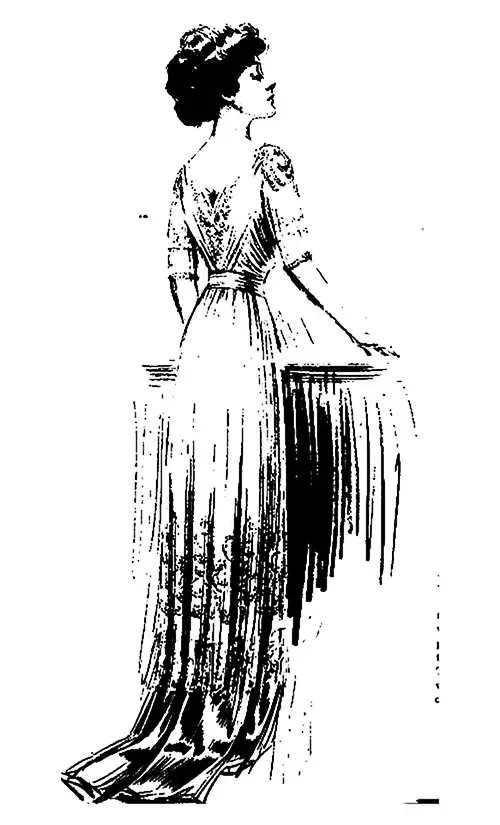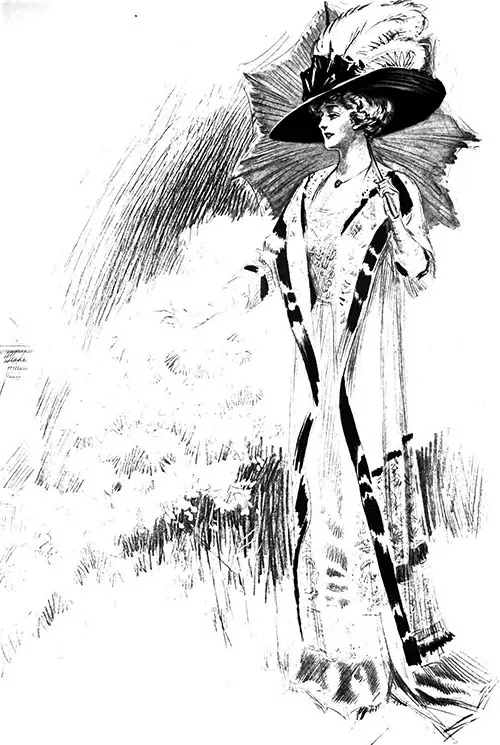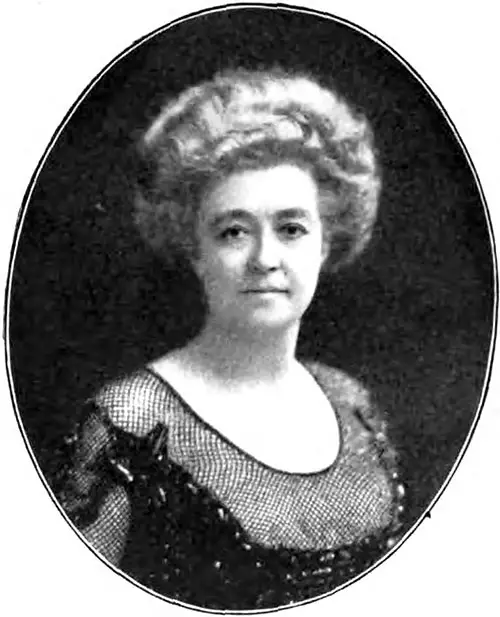Complex Character of Chiffon Wraps and Dresses - 1910

Transparent wraps and dresses call for marvelous foundations of silk and chiffons according to an article on the complex character of the new chiffon wraps and dresses by Mrs. Simcox, New York’s greatest dressmaker and arbiter of the modes in this country.
Twice a year I take a vacation. That is what I call my semi-annual trip to Europe. It is a nice name, and it half helps me to believe that I am not working when I make a hurried tour through Italy, lunch in Switzerland and leave Paris after a frenzied fortnight spent at the dressmaker's, milliner's, restaurants, races, and theaters. I come home with an indistinct impression of having been in a dozen places at once ever since I left New York.
I carry with me a vague recollection that someone pointed out Florence to me as we passed through it in a cloud of suffocating Italian dust, but perhaps it was only Pisa.
I recall with envy that a very small friend of mine who was taken on a six-month foreign tour at the age of five could chant in a sort of recitative the name of every hotel she stayed in abroad.
For my part, I should have a sinking feeling if anyone asked me whether the Waldorf was in Rome or Paris by the time I finish one of my vacations.
However, after I have been home a short time, the seas and cities begin to sort themselves out in my memory. I am mildly surprised to find that the Tiber does not flow into the Seine, and that the Swiss Alps are a little more than a five-minute walk from Venice.
More surprising still I discover that I have really enjoyed my cinematographic vacation and that I come home with my mind full of fresh ideas and pleasant memories.
Last summer, I went to Ostend and found it rather uninteresting. This year, I expect to be at Trouville for the Grand Prix. They have a very pretty racetrack there—prettier even than the one at Auteuil, for the women do not stay in the pesage between the races, but wander around on a wonderfully kept green lawn that looks like a beautiful piece of velvet spread out under their feet. It makes a very effective setting for their race costumes as they form into little groups or stroll about the enclosure.
I have just been having some things made for my trip in August, and I am rather well pleased with the way they have turned out. One of them is a dress of mauve-colored satin embroidered heavily with satin beads dyed a slightly deeper color.
It is draped with cloud-gray chiffon, and that again is covered with a second layer of chiffon matching the peculiar pinkish mauve of the satin. In fact, everything is draped, not once, but many times this year. It has made the Summer a season of expensive simplicity for women who attempt to carry out the more extravagant phases of the new modes.
This little dress of mine is as unpretentious as possible so far as lines are concerned. The waist is a semi-décolleté bodice with a deep V-shaped neck opening at both the front and back.
The bead embroidery and the drapery of the gray and mauve chiffon follow the lines of the neck. On the shoulder, the drapery is held in place by a sort of fantastic epaulet of the beads.
The over-blouse has the usual short, close pagoda or kimono sleeve—the undersleeve of satin heavily embroidered and the oversleeve finished quite simply with two or three rows of the big satin beads.
The satin underskirt fits the figure closely and is cut with a slight train. It is embroidered heavily in a deep band outline between the knees and the ankles.
The overskirt of the two-toned chiffon is simply gathered in at the waist and falls in straight soft folds weighted at the bottom by a band of embroidery. It is just long enough to cover the embroidery on the foundation skirt.
The dress is a conservative version of the present fashions. It has the close, circumscribed lines, but they do not lend themselves to the exaggerated scantiness of the extreme French models.
The pagoda sleeve, the use of the parti-colored chiffons, the suggestion of the band on the skirt carried out in the embroidery and beadwork, represent the most salient features, of the new styles.
It would be hard to pick out any single characteristic of the season's fashion as the one that belonged preeminently to the Summer of 1910. One month borrows from another, and it is difficult to draw any hard and fast line between them as far as fashions are concerned.
The warm weather, of course, makes possible the use of transparencies to a greater extent than at any other time of the year, wraps and dresses are made of tissue, mounted on gauze and lined with chiffon until they resolve themselves into cloudy draperies built up of fugitive tones and colors.
One of my own wraps that I am frankly delighted with, is also made in mauve-pink chiffon. The foundation is white satin veiled with blue chiffon. But the blue turns into orchid color when it is veiled with two layers of pink chiffon, and one almost loses the color altogether under the outer covering of mauve.
The lower part of the wrap is trimmed with a deep border of Pompadour chiffon-a black background almost hidden by a riot of pink and blue and lavender flowers.
The front of the coat is trimmed with huge revers, strongly reminiscent of the bygone Directoire styles—faced with the flowered chiffon and partially covered by a collar of beautiful old Flanders lace.

The Lower Part of the Wrap Is Trimmed with a Deep Border of Pompadour Chiffon
The wrap is lined with mauve chiffon-don't for a minute fancy that the satin was the lining—that was merely the cornerstone of the structure. The edges of the coat were bound with cloth of gold covered with black chiffon.
I turn from the contemplation of my coat rather reluctantly. It is lovely, but there are other matters of more practical interest. One of them is the subject of morning dresses.
Foulard, of course, holds first place. It is pretty, serviceable and a general favorite. I have made a great many foulard dresses this summer with a sort of simulated tunic formed by the border.
I have just finished one now in a deep shell-pink silk with a small white figure and a popular selvage band. The border is used to edge a surplice opening on the waist and to suggest a tunic outline on the skirt.
The latter is made with a panel at the center of the front. The border starts from under it just below the knees, slopes upward across the sides until it reaches the back where it turns at a sharp angle and runs up to the shoulders, broken, of course, at the waistline by the belt.
I use the tunic or the tunic outline on a great many dresses and find that it is still very well liked. Of course, the banded skirts are newer. One of the latter that I made recently was in a dress of fine white net printed closely in dull Baltic blue.
The skirt was draped up below the knees by a sash of sapphire-blue velvet tied in an immense bow at the left side of the front. The upper part of the skirt bagged over the sash, almost hiding it from view.
The waist was the usual Magyar blouse with the short sleeve in one with the body. It was trimmed with a plaited frill at the neck and with a simulate Russian closing, where the net was buttonholed in a Wall-of-Troy design instead of the usual scalloping. A frill of Valenciennes lace was set under the edged the opening.
Another dress with a skirt draped in much the same fashion was of dark blue silk voile caught up with cherry-red satin. A broad band of the satin passed around the figure just under the arms covered the foundation bodice from the bust to the waistline.
The overbody was the familiar peasant blouse again with its short kimono sleeve. The short sleeve is omnipresent in all the Summer dresses.

Simcox, Mrs. Clara E., "There's Many A Slip," in The Delineator, New York: The Butterick Publishing Company, Vol. LXXVL, No. 2, August 1910, p. 98.
Editor's Note: Some terminology used in the description of women's clothing during the 1800s and early 1900s has been changed to reflect more modern terms. For example, a women's "Toilette" -- a form of costume or outfit has an entirely different common meaning in the 21st century. Typical terms applied to "toilette" include outfit, ensemble, or costume, depending on context.
Note: We have edited this text to correct grammatical errors and improve word choice to clarify the article for today’s readers. Changes made are typically minor, and we often left passive text “as is.” Those who need to quote the article directly should verify any changes by reviewing the original material.
